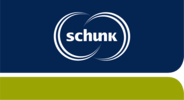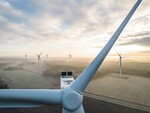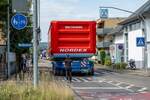News Release from Schunk Group
Wind Industry Profile of
2018 was a Successful Year for the Schunk Group
2018 was another successful year for the Schunk Group. “We showed profitable growth, increasing our sales by 7.4 percent to 1.28 billion euros,” says Dr. Arno Roth, CEO of the Schunk Group.
This means that the Schunk Group grew twice as fast as the global economy, which grew by 3.7 percent. The profit was also satisfactory, with the equity ratio rising to 67.1 percent and thus further improving Schunk’s financial stability.
Growth across all divisions
All divisions showed growth. Although from a regional perspective absolute growth was strongest in Germany, the Schunk Group also showed significant gains in the strategic growth market of Asia, thus further expanding its global presence.
“We recorded considerable growth, despite the fact that important markets faltered,” says Dr. Roth, summing up the market development. For example, global car production declined. “In this respect, the ongoing strengthening of our sales force and our pronounced customer orientation are paying off. Innovative products such as the Schunk Smart Charging System also enabled us to increase sales,” adds Dr. Roth.
Strong investments for the future
The Schunk Group’s financial stability facilitated the making of substantial investments in the past business year: 100 million euros were invested in new buildings at the Bordeaux, Helmond, Heuchelheim, Wettenberg and Reiskirchen-Lindenstruth sites, among others.
The Schunk Group hired more staff in 2018 to achieve this challenging level of growth, boosting the total number of its worldwide employees to 8,580. “Our good sales figures in 2018 are the joint success of all our employees,” said Dr. Roth. “That’s why the Schunk Group’s employees will once again participate in the profits for 2018.” Total profit participation for 2018 will amount to about 25 million euros. Depending on the employees’ location and amount of time that they have been with the company, this results in each person receiving up to 6,000 euros in company profits – quite a considerable sum.
Slower growth since the end of 2018
There were nevertheless already indications of slowing growth at the end of 2018. “The automotive and semiconductor markets, which are particularly important to us, have cooled down significantly, and this trend has continued in 2019,” summarizes Dr. Roth. It is an advantage here for Schunk to be broadly positioned and leverage its innovations to become less dependent on the automotive market and in particular the combustion engine.
Portfolio expansion: entering the photonics market
The Schunk Group’s participation in OptoTech was particularly important in 2018. OptoTech manufactures and sells machines, services, measurement technology and coating systems as well as software, spare parts and consumables for the optical industry. The company is active worldwide and has around 250 employees. “Technologically speaking, OptoTech is a very interesting company,” says Roth, explaining the reasons for participating. “As one of the world’s technological and process leaders for optical machines, it is thus well-suited to the Schunk technology group. This investment helps Schunk strategically expand its positioning, gain access to the growth market of photonics and reduce its dependence on the automotive industry.”
The Schunk Group has also broadened its positioning in the North American environmental simulation market. With the purchase of Cincinnati Sub Zero - the largest acquisition in the history of the Schunk Group - the Weiss Technik Division has risen from number four to number one there and now boasts a market share of around 25 percent.
“We are also further expanding our technological leadership in our existing business and transferring our technological expertise to new products,” adds Dr. Roth. Weiss Technik has achieved groundbreaking success in the field of refrigeration technology here.
Weiss Technik develops “climate killer” replacement
Almost all of our technical products are put to the test before being launched on the market. This is especially important for safety-related products. When taking off in an airplane, for example, you want to be sure that its parts can also withstand an outside temperature of minus 60 degrees at an altitude of 10,000 meters.
That is why all the parts go through meticulous testing – in special industrial climate test cabinets, as manufactured by Weiss Technik. This nevertheless poses a problem: only a single high-performance refrigerant can produce the extremely low temperatures of down to minus 70 degrees required for temperature shock tests. Referred to as R23, it is unfortunately extremely climate-damaging. If it gets into the atmosphere – which cannot be excluded despite all precautions – it is a 15,000 times stronger greenhouse gas than CO2, making it a real climate killer. The EU has reacted by only allowing the use of R23 as an exception and applying a strict degressive quota scheme, which is already causing supply bottlenecks. It is therefore foreseeable that R23 will soon no longer be available as a refrigerant. But how can aircraft components be tested in that case?
The solution comes from Weiss Technik rather than from a chemical company. The environmental simulation provider’s engineers have developed a substitute after seven years of research in cooperation with partners from the chemical industry and science. Although the new refrigerant WT69 has the same properties as R23, it is 90 percent less harmful to the climate. This ensures that the necessary product tests can be performed even after R23 is finally prohibited – and WT69 is also a more climate-friendly alternative to R23 for large refrigeration plants in the chemical industry or for blood banks.
In the context of the discussion about the future of the combustion engine, Schunk is also increasingly focusing on the topic of electromobility, as a number of already successful or promising innovations demonstrate.
Storing wind and solar power
Storing electricity from wind and sun – the energy transition still lacks this missing component. A lot of wind and sun after all generates more electricity than can be fed into the power grids. Many regions also lack the connected wattage in their power grid required for electric mobility in order to allow the quick charging of multiple electric vehicles at the same time. Buffer storage systems that make electricity available at all times – even when there is no wind at night – are missing. Schunk has launched a cooperative project with Alzenau-based CMBlu Energy AG to develop and produce electrodes for large power storage systems that should make this possible.
These power storage systems are inexpensive and can be scaled as required. They operate according to the principle of conventional redox flow batteries, in which liquids containing dissolved electrolytes store or release the power. CMBlu uses electrolytes from organic substances and accordingly refers to its batteries as “organic flow batteries.” Interestingly, the organic electrolytes are obtained from lignin, which is contained in every plant with structure, such as wood. The pulp and paper industry generates millions of tons of lignin as a waste product. There has been no possibility of recycling the lignin to date, most of which has been incinerated.
An organic flow battery essentially consists of two tanks from which the electrolytes are pumped into an energy converter. There, the electrolyte solution flows over graphite electrodes developed and manufactured by Schunk. Power is stored in the electrolyte by means of an electrochemical reaction and can be fed back into the power grid if needed.
Organic flow technology offers considerable advantages over lithium-ion batteries: while costs are low, the availability of resources and operational reliability are high. Organic flow batteries are particularly suitable for stationary applications in the power grid – for example as power storage units for e-car charging stations.
1,000 charging systems for electric buses in use worldwide
What began in 2014 with the in-house innovation competition has now become a showcase electric mobility product for Schunk. The technology group recently delivered its 1,000th roof-mounted pantograph for electric buses. Schunk Smart Charging enables quick and easy charging of electric buses via a power contact on the roof. The system is in use worldwide, with 100 buses running between Amsterdam and Schiphol Airport alone; others are on the streets of Krakow, Moscow, Eindhoven and Cologne, and they are soon also coming to Brussels and Oslo.
Automatic charging of electric cars
Schunk’s engineers have derived another idea from the Smart Charging success: the electric car autonomously drives to the electric charging station and is automatically charged from below – this could be the future of charging stations. With the Underbody Charger, Schunk has developed the e-charging station prototype of the future that enables the autonomous, efficient, safe and convenient charging of different vehicle types in just a few seconds. This is made possible by a charging station that can retract into the roadway, the docking module that is installed in the vehicle floor, and the extremely high power transmission of up to one megawatt. The automatic charging process can thus be shortened to only a few minutes – even if the batteries are completely empty – and easily integrated into the everyday use of vehicles. The Underbody Charger is also ideal for autonomous vehicles – thanks to this combination, you will no longer have to worry about driving or charging because the vehicle will recharge all by itself.
- Source:
- Schunk Group
- Author:
- Press Office
- Link:
- www.schunk-carbontechnology.com/...
- Keywords:
- Schunk Group, division, battery, wind enery, solar, growth, sales, porfolio, investments
























